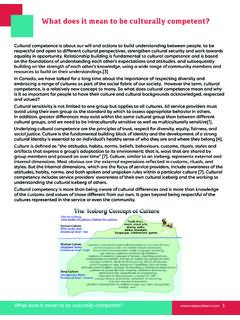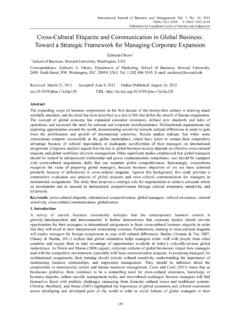Transcription of Intercultural Communication in Organizations
1 373 CHAPTER 11 Intercultural Communication in OrganizationsCHAPTER OBJECTIVESA fter reading this chapter, you should be able to1. discuss how dimensions of the cultural context affect Organizations across cultures;2. identify how the environmental context affects doing business in other cultures;3. identify variables in the perceptual context and how they influence business with other cultures;4. compare and contrast sociorelational contexts on the job across cultures;5. discuss some verbal and nonverbal differences across cultures;6. compare managerial styles of Japanese, Germans, Mexicans, Chinese, and Arabs; and7. describe differences in manager subordinate relationships in Japan, Germany, Mexico, China, and Arab COMMUNICATION374 Imagine the following scenario:You have just graduated from college and accepted a management job with Acme Corporation.
2 Acme has placed you in one of its Mexican offices. During your first week in your new job, you decide to schedule a meeting with your Mexican employees. The meeting is scheduled for 9:00 on Wednesday. On Wednesday morning, you show up a bit early to prepare for your meeting. By 9:00 , not a single employee has arrived for the meeting. By 9:20 , two people finally show up. Not until 9:45 are all the members of the team in attendance. What has happened? You are confused, frustrated, and feeling a bit business in Mexico (and in many other countries) is different from doing busi-ness in the United States. Mexican cultural values, such as collectivism and large power distance; Mexican social expectations; and Mexican workplace practices of workers and managers are different from those of workers and managers.
3 To be sure, they are so different that managers working in Mexico often find themselves ineffective. The manager who does not take the effort to learn about these differences and adjust his or her managerial style accordingly will end up just as you did in the above scenario frustrated and has more than 4,000 stores in the United States. Of all Americans, 90% live within 15 miles of a Wal-Mart. On average, every American household spends just more than $2,000 each year at Wal-Mart. In the United States, every seven days, 100 million people shop at a Wal-Mart. Wal-Mart is also successful internationally. It is the largest retailer in both Canada and Mexico, and the second largest in Britain. Worldwide, more than seven billion people shop at Wal-Mart.
4 That s more than the world s population. So, this year, the statistical equivalent of every person on the planet will shop at a is clearly a financial success, both nationally and internationally. But as Landler and Barbaro note in 2006 Wal-Mart closed its stores in Germany. The chain has had difficulty breaking into the Korean and Japanese markets as well. Something was not working in Germany, and many believe that some of Wal-Mart s international problems stem from the company s arrogance and overestimation of its competence . For a company that boasts seven billion customers a year, a certain degree of confidence is understandable. But in some places, Wal-Mart s attempts to impose its values on the market just do not work at least not in places such as Germany, Korea, and to its failure in Germany, a Wal-Mart international spokesperson commented that it was a good lesson for the company and that they have learned to be more sensitive to cultural differences.
5 For example, many Germans found the idea of a smiling greeter at the However objective and uniform we try to make Organizations , they will not have the same meaning for individuals from different cultures. Fons Trompenaars1 CHAPTER 11 Intercultural Communication in Organizations375door of every Wal-Mart off-putting. In fact, many male shoppers interpreted it as flirting. The company also failed to foster good relations with German labor unions (Wal-Marts in the United States are not union). At one point during its tenure in Germany, Wal-Mart closed the headquarters of one of its chains and moved it to another geographic location a common occurrence in the United States, usually accompanied by employees packing up and moving with the company. But in Germany, most of the employees quit rather than moving.
6 A major problem was that the American managers in Germany just did not understand the German market or and Barbaro point out that the conglomerate also has made cultural gaffes in Brazil and Mexico. In Brazil, the company focused a campaign on golf clubs, in a country where many do not play golf. In Mexico, it emphasized ice skates! In Korea, the Wal-Mart product shelves were so tall that customers had to use ladders to reach the products! The point of this account is that the management and sales tactics of one country, no matter how successful they may be in that country, probably are not suitable for another country. Even if you can boast seven billion shoppers, you still need to be perceptive of cultural and managing people from different cultures within an organizational con-text represents one of the greatest challenges for the corporate world in the new millennium.
7 Few managers will survive and function effectively without an understanding of the subtleties and complexities of managing others in a multicultural and multinational business environ-ment. Businesses and Organizations from virtually every culture have entered into the global marketplace. The top 10 countries with which the United States trades, in terms of both imports and exports, are, in order, Canada, China, Mexico, Japan, Germany, the United Kingdom, South Korea, France, Taiwan, and Brazil. In 2010, trade with these 10 countries accounted for nearly $3 trillion ( , $3,000,000,000,000).4 Within borders as well, the face of business is becoming more and more Intercultural . In 2007, Hispanics owned million businesses in the United States, an increase of 44% from 2002.
8 These firms accounted for of total employment. That same year, African Americans owned nearly two million businesses, an increase of from 2002. These businesses employed nearly one million people and generated $140 billion of business. Asians owned million businesses in 2007, an increase of 40% from 2002. These firms accounted for 6% of all nonfarm businesses in the United States, of total employment, and 2% of total receipts. The government defines Asian-owned businesses as firms in which Asian Indians, Chinese, Filipinos, Japanese, Koreans, Vietnamese, and other Asians own 51% or more of the stock or equity of the the dramatic cultural transformation in today s marketplace, the relevance of inter-cultural Communication competence cannot be overstated.
9 To compete in the global and markets, today s managers must possess the skills to interact with people who are different from MANAGEMENTThe purpose of this chapter is to introduce some of the salient issues affecting Intercultural management. This chapter will take the components of the model of Intercultural com-munication introduced in Chapter 1 and apply them to Intercultural management. First, the Intercultural COMMUNICATION376cultural context within Organizations will be explored prior to a discussion of the environ-mental context. Next, the chapter will identify the variables in the perceptual context and how they affect business in other cultures. The chapter will then compare and contrast sociorelational job contexts across cultures, along with discussing some verbal and nonverbal differences.
10 Finally, the chapter will examine managerial practices among Japanese, German, Mexican, Chinese, and Arab is no culture-free theory of management. Managing other people is the responsibil-ity of people who, like everyone else, have been enculturated and socialized into a cultural set of values and beliefs that governs their thinking, emotions, and behaviors. Like commu-nication, management is culture bound. Moreover, managerial perceptions regarding the factors that lead to organizational success vary across cultures. Unfortunately, many managers are ill equipped to handle overseas assignments. In fact, roughly 40% to 50% of all managers sent abroad receive no formal cross-cultural As a result, up to 40% of overseas assignments are Although fostering competent Intercultural managerial skills represents an enormous challenge, the rewards of successful international commerce are Philip Rosenzweig of Harvard University argues that successful cross-cultural management depends on the abilities of managers to communicate effectively.












